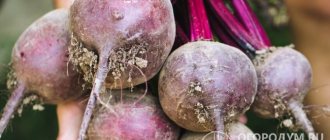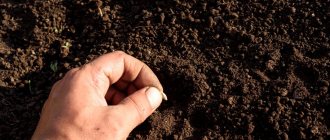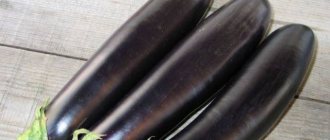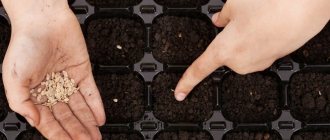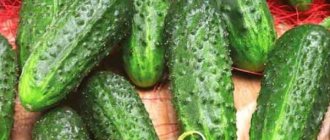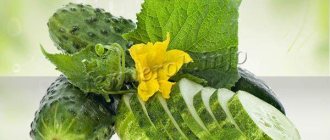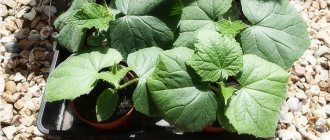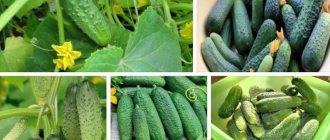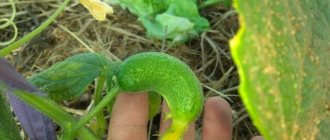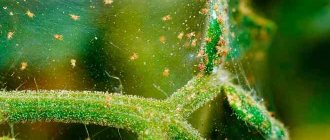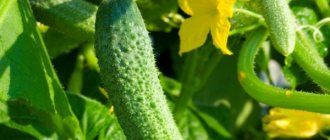The early maturing Dutch hybrid Adam f1 is suitable for individual cultivation in compost pits and barrels without molding the bushes, on a trellis with minimal gardening skills. The culture is unpretentious in care thanks to its small leaves, which do not absorb the main nutrition and do not shade the fruits from the sun.
In this article we will reveal the secrets of growing a hybrid, shaping bushes, protecting against downy mildew and insects in protected and unprotected soil.
Description and characteristics of the Adam variety
The Adam variety is considered a parthenocarpic hybrid. The species is listed in the State Register of the Russian Federation in
2002, although it appeared in the country back in 1898. The crop is recommended for cultivation in any climatic region. Adam allows construction in open ground and in a greenhouse.
The species is considered early ripening. The gardener receives the first fruits 45-52 days after germination. The productivity is high: up to 10 kg of cucumbers are harvested from 1 m2. The variety is classified as indeterminate, but the bushes are not too tall. Adam is grown on a trellis.
There is no need for insects when pollinating female flowers. But even if the bees land on the flowers, this will not negatively affect the quality or shape of the cucumbers.
The stems are thick with a light green color, the leaves are small. The fruits are characterized by a bright green color. Zelentsy grow with small bumps and white fluff. The length of each cucumber is 10 cm, diameter – 4 cm, weight – 90 g. It has good taste. The aroma is common, typical of most cucumbers.
The variety is resistant to many diseases. The shelf life is up to 14 days.
How to properly care for Adam
It’s not that the crop requires careful care, but if you follow the recommendations, you will be able to significantly increase the quality of the harvest.
Regularity of irrigation and fertilization
If you decide to sow or plant seedlings, then do not forget about watering and fertilizing:
- It is better to water the bushes in the middle of the day;
- watering is moderate, do not worry about air humidity if you grow cucumbers in greenhouse conditions;
- for irrigation it is better to use warm rainwater heated to 20 degrees;
- before flowering, add mullein solution, after 10 days the procedure is repeated;
- Potassium nitrate is used during the fruiting period.
Formation and garter of bushes
When 5 leaves appear on the stem, it is worth tying the bush to a support, this will make it more convenient to harvest. It is recommended to use vertical trellises, especially if we are talking about a greenhouse. When planting in the ground, use pegs.
When the plant reaches a height of 40-50 centimeters, the side shoots and stepsons should be removed.
Protection from diseases
If you follow the watering rules and carry out timely fertilizing, no specific protection is required. If signs of disease appear, shoots are removed and diseased plants are burned.
Advantages and disadvantages
The popularity of the variety is justified by the following advantages:
- high productivity;
- early fruiting;
- excellent external characteristics of the fruit;
- resistance to diseases;
- ability to self-pollinate;
- endurance to transportation.
Expert opinion
Stanislav Pavlovich
Gardener with 17 years of experience and our expert
Ask a Question
Attention! The listed advantages allow novice gardeners to grow the crop.
We cannot remain silent about the shortcomings of the Adam species:
- inability to use seeds from the harvest for planting for the next season;
- The fruits have thin skin, so they require a delicate attitude.
Characteristics
The Adam cucumber is in great demand among gardeners, which is understandable. The ripening period is 45-50 days from the moment when sprouts form. Productivity is 10 kg/m2. Fruiting lasts until the air temperature at night and during the day drops to +8C. Germination rate 95%. It is not advisable to collect seeds from cucumbers for subsequent planting, as it will not be possible to achieve the desired result.
Fruit:
- green;
- cylindrical;
- no unevenness;
- up to 12 cm in length;
- up to 3 cm wide;
- green or dark green;
- weight does not exceed 90g;
- with small spines.
Note! The pulp has moderate juiciness, density and a sweetish taste. Small seeds in small quantities.
Subtleties of growing crops
A gardener who wants to get a high yield must take into account the intricacies of growing Adam cucumbers.
Preparation of planting material
Before growing seedlings, the following activities are carried out:
- cucumber seeds are placed in the refrigerator for a couple of days;
- Germination occurs on wet cloth in a warm place.
It is also necessary to prepare the container where the seedlings will be placed. Peat glasses or plastic containers are suitable for these purposes. As for the latter, they must have drainage holes. The prepared containers are filled with fertile soil.
See also How to improve the growth of cucumbers: effective folk remedies
Growing seedlings
Most gardeners prefer to deal with seedlings. This measure allows you to get the fruits earlier. Work begins in mid-spring. The process of growing seedlings takes 1.5 months.
The prepared planting material is sent into holes, the depth of which should be 2 cm. The seeds are sprinkled with earth on top.
In order for the seedlings to sprout quickly, the beds are covered with plastic film, which ensures a greenhouse effect. The shelter is removed with the appearance of the first shoots.
Culture at this stage needs sufficient illumination. Otherwise, it will go up and the stems will remain thin. For these purposes, you can purchase a phytolamp.
It is also necessary to ensure timely watering and fertilizing. Planting in open ground or a greenhouse occurs when two true leaves appear on the plant.
Expert opinion
Stanislav Pavlovich
Gardener with 17 years of experience and our expert
Ask a Question
Important! One and a half weeks before the intended planting, hardening is carried out. Containers with seedlings are taken out into the air for a short time every day.
Selection and preparation of a site
Before planting, the following varieties can grow in the garden bed: tomatoes, potatoes, cabbage, legumes, and onions. Undesirable predecessors for cucumbers are pumpkin crops (zucchini, squash, melons, watermelons).
The Adam species should be planted in a place that is well lit and protected from drafts.
The soil is dug up or loosened to a depth of 25 cm. One of the following fertilizers (per 1 m2) is first sprinkled on the ground:
- a bucket of manure and 250 ml of ash;
- 30 g of complex action mineral fertilizer – nitroammofoska;
- drugs Gumi-Omi, Rodnichok, Zdraven.
Timing and planting process
Cucumbers are planted when the air temperature reaches +19°C. In this case, the earth should warm up to +15°C.
If you plan to grow a crop in a greenhouse, the period will depend on climatic conditions, taking into account the minimum temperature regime.
Planting seedlings in open ground in the regions of the middle zone is carried out at the beginning of summer.
The seedlings are taken out along with a lump of earth and placed on beds without deepening. Watering is important at this stage. The soil is also mulched. If planting with seeds is carried out, it is carried out a week earlier. The depth should be 3 cm.
Cultivation is carried out on a trellis, so a dense planting option of 30 cm is possible.
Watering and fertilizing
Water the cucumbers every 1–2 days at the rate: 10–15 liters per 1 m². Use warm, settled water. During dry periods, arrange sprinkling, irrigate the leaves, but in such a way that the water on them dries before it gets dark and cool. If the site has a constant water supply, organize drip irrigation. It is recommended to lay mulch of grass, hay or straw around the bushes. These materials will prevent the soil from drying out and the germination of weeds; in addition, by overheating, they will serve as additional fertilizing.
Cucumbers have a shallow root system, and require a lot of nutrients to form vines and yield. The fertilizers you apply before planting will only last for 1–3 weeks. Start feeding: seedlings - a week after planting, and cucumbers sown immediately in a permanent place - when the first flowers appear. In the future, fertilize the bed every 7-10 days until the end of the growing season.
Cucumbers need to be fed often, so it’s more profitable not to buy fertilizers, but to make them yourself
Alternate the following feedings in different sequences:
- “green fertilizer” - fill the container with nettles or other succulent weeds and tops, fill with water, cover and place in a warm place (in the sun, in a greenhouse). The fertilizer is ready when the contents turn into a homogeneous mass with the smell of manure. Before watering, dilute with water 1:5;
- infusion of fresh mullein or bird droppings. Fill the bucket a quarter full with fertilizer and fill it with water. Cover and place in a warm place to ferment for 5-7 days. Before watering, dilute mullein infusion with water in a ratio of 1:10, dung infusion - 1:20;
- dry bird droppings, horse concentrate and other organic matter from the store must be prepared as written in the instructions;
- wood ash - 1 tbsp. shake in 10 liters of water and pour until the heavy fractions settle;
- yeast - pour 1 packet of dry baker's yeast (10-12 g) into a 3-liter tank, add 3 tbsp. l. sugar, pour warm water up to the hanger. When fermentation begins, foam appears on top, pour this wort into a watering can. Fill with water to the top and water. Yeast feeding only works in warm weather;
- mineral fertilizing - 30 g of nitroammophosphate per 10 liters of water;
- ready-made complex fertilizers containing all the necessary macro- and microelements: Fertika, Agricola, BioHumus and others marked “for cucumbers”. Use as directed;
- Foliar feeding should be done in cool and rainy weather, when metabolism slows down and the absorption capacity of the roots decreases. You can use all of the above solutions, but on the leaves (except for yeast).
Feed on damp soil, the application rate is 0.5 liters for young plants and 1-2 liters for an adult fruit-bearing bush. A week after feeding with ash, be sure to add organic matter or nitrogen-containing fertilizers.
Video: three best fertilizers for cucumbers
Recommendations for plant care
Adam cucumbers do not have any special care requirements. The following fundamentals of agricultural technology must be observed:
- Cucumbers need to be cultivated once every five years. Otherwise, the crop is susceptible to diseases and pests.
- Beds located in open ground or a greenhouse must always be free of weeds.
- Since the roots of cucumbers are usually bare, it is necessary to systematically loosen the soil shallowly and hill up the plants.
- Watering is carried out weekly until the flowering period. During the fruiting stage, this process should occur twice a week. Watering is carried out with water without chlorine; the temperature of the liquid must be at least +24°C.
- If the variety is grown in a greenhouse, fertilizing is carried out 5 times. It is preferable to use organic and mineral fertilizers.
See also Why cucumber leaves curl inward and how to deal with it
Growing and care
Seedling
It is best to plant it in peat pots. The seeding depth is 1-2 cm.
Cucumbers do not tolerate transplantation well, so it is better not to further injure them with temporary containers.
Young seedlings do not need feeding. They require watering as needed and placement on sunny windowsills. When each bush has 4 true leaves, you can transfer them to the garden bed.
Watering rules
It is necessary to water the crop daily or once every two days, depending on the air temperature. For every square meter, 10-15 liters of water are required. You cannot pour cold water from a well; it is left to stand in barrels throughout the day. The optimal time is in the evenings, but early in the morning is also possible.
During periods of drought, the foliage is sprayed with a spray bottle or sprinkling. You should not add a lot of liquid: it should dry by evening so that the bushes do not get too cold at night.
Soil fertilization
The first feeding of plants planted with seedlings is carried out a week after transplantation. If the crop is planted with seeds, then you need to start feeding it at the beginning of flowering.
Before flowering begins, a solution of mullein is added to the soil (a glass of manure is dissolved in a bucket of water). 1 bucket is enough for 1 sq. m, additionally a teaspoon of potassium sulfate and the same amount of superphosphate are diluted in it.
During fruit development, potassium nitrate is needed. 25 g are diluted in 15 liters of water.
How to form bushes?
The formation of cucumbers grown on a trellis occurs as follows:
- the stepsons, ovaries and flowers on the first five leaves are pinched;
- the central lash is tied with twine to the trellis as the bush grows upward;
- the central lash is pinched or thrown over the top point of the trellis so that its growth is directed downwards.
How to increase productivity?
A convenient way to grow cucumbers is by trellis. By tying the stems to the wire, you increase the lighting. Productivity will be higher if fruits are collected systematically.
The trellis is very easy to make. You will need thin galvanized wire and two poles. The posts can be wooden, but they must be treated with a solution that will protect the material from pests and rot. The bark is completely removed, the ends of the pillars that will be dug in must be lubricated with resin. After installing the posts along the edges of the seedlings, stretch three or four rows of wire and tie the lashes to it using thick threads.
Protection from diseases and pests
The variety is resistant to viral mosaic and powdery mildew, but is susceptible to the following diseases:
- white rot - diseased plants are destroyed, and healthy ones must be treated with Bordeaux mixture;
- anthracosis - drugs with a high sulfur content, Bordeaux mixture, are used against this problem;
- gray rot - the affected cucumbers are thrown away, and the rest of the crop is treated with a mixture of calcium nitrate;
- downy mildew - for the purpose of prevention, the crop is treated with a 1% solution of Bordeaux mixture.
- Pests for the crop are aphids and mole crickets. For preventative purposes, garlic, calendula, marigolds or coriander are planted near the beds.
Reviews
Anna Prokhorenko, 34 years old
We tried planting different cucumbers in open ground. Adam really liked it. There were no particular difficulties during cultivation, and the harvest was harvested from early July to mid-September.
Alexey Malofeev, 57 years old
When I bought the seeds in the store, they said that the cucumbers were simply perfect - 100% germination, the harvest was large, they didn’t get sick, and they taste great. In principle, this is how it turned out. The cucumbers were exactly the same, even, strong, and crunchy. We always ate them fresh, made salads and okroshka. And they preserved it for the whole winter.
Olga Kuznetsova, 44 years old
I heard good reviews about Adam cucumbers from my neighbors in the country. But somehow they didn’t work out for me - either the seeds were bad, or I shouldn’t have hardened them in the refrigerator before planting. It seems that they are considered early, and the first cucumbers appeared only after two months. Therefore, the harvest was small and short. Although the cucumbers taste really good.
Elena Alexandrova, 32 years old
Our cucumbers grow in a polycarbonate greenhouse; conditions do not allow them in open ground. We settled on several self-pollinating hybrids: Meringue, Adam, Courage, German, Masha. They are undemanding in care. We stretch the trellises, water them generously with warm water and feed them 5-6 times a season with wood ash, humus or manure. They bear fruit well, delighting with an early and long-lasting harvest of up to 10 kg per meter of area. Cucumbers retain their excellent appearance and taste for a long time and can be grown for sale.
Fyodor Uspensky, 38 years old
Adam F1 cucumbers are resistant to many diseases, but are susceptible to downy mildew. Therefore, after the appearance of 4-5 true leaves, we carry out preventive treatment - spray with 1% Bordeaux mixture (lime solution of copper sulfate). If the disease still appears, then make the solution more concentrated (2%) and spray it several times at intervals of a week.
Harvesting and application
Cucumbers can be harvested in early June. But in general, everything depends on the timing of planting seedlings in the soil. The collection is carried out as carefully as possible, picking cucumbers without damaging the stem of the bush. The greens are also placed in prepared containers carefully so as not to injure the skin.
The harvest is stored in a cool place. Thus, it will be stored for up to 14 days. If everything is done correctly, the variety will not lose its appearance and taste.
Cucumbers can be salted, pickled and eaten fresh. Farmers use the Adam species for sale.
Features of agricultural technology of the variety
The gardener independently chooses the planting method - seedlings or non-seedlings. Seedlings are a more traditional method.
Preparatory work begins with the arrival of spring. To increase the resistance of seeds to unfavorable environmental conditions, the seeds are frozen in the refrigerator for three days. Then they are placed wrapped in a dry cloth in the refrigerator, and under no circumstances in the freezer. To germinate, the seeds are wrapped in an already wet rag and left in a draft-free room.
Cucumber Adam F1: reviews from gardeners
There are a lot of comments about the variety. They write that Adam cucumbers bear fruit consistently and the yield is high. The culture is praised for its rapid growth and strong vines on which juicy cucumbers ripen. Adam cucumbers have gained many fans among gardeners and entrepreneurial farmers due to their rich aroma, juiciness and sweet taste. They write that the variety is not bitter at all.
Many reviews say that the culture is completely unpretentious, it is resistant to pests and diseases. Cucumbers of this variety are very easy to care for; they are unpretentious. They also write that the foliage does not turn yellow in stable sun, the yield lasts until the very end of the season. There are comments claiming that even when the bush begins to turn yellow, cucumbers can still ripen on it.
History of variety selection
The Adam cucumber variety appeared thanks to the work of Dutch breeders. The creator of the vegetable crop was the company BejoZaden B. V, formed in 1978 by the merger of two Dutch seed organizations. Russian vegetable growers were able to purchase the company's products for the first time in 1989. The main focus of BejoZaden's work was the cultivation of varieties of carrots, onions, cabbage, beets, tomatoes and cucumbers. In total, the company has produced more than 800 hybrid varieties. In 2002, Adam f1 cucumbers were officially included in the State Register of the Russian Federation.
